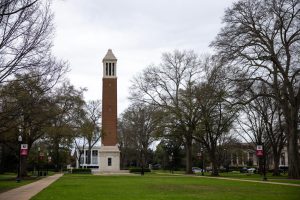Roadside signs maintain old south stigmas
“Go to church or the Devil will get you” has been a roadside sign for over 30 years. Former UA students and residents of the area said the landmark could perpetuate antiquated ways of thinking.
July 2, 2019
Standing along I-65 North between Montgomery and Birmingham is a roadside sign that has become a humorous Alabama staple that embodies what the state has become.
“Go to church or the Devil will get you” has been standing tall for three decades and has been rebuilt since a storm damaged it in 2016. W.S. Billy Newell is the late construction contractor that built the iconic sign many years ago on his private property that sits parallel to I-65 north of Prattville. Newell had a strong belief in God and showed his love for America in another sign alongside the highway reading, “America: Love it or Leave it.”
I-65 North is a well-traveled interstate that has seen an influx of traffic over the years, especially in travel to and from Alabama’s beaches. Brittni Milledge, a recent UA graduate and lifelong resident of Montgomery, said she has driven by the sign countless times.
“Honestly, I’ve seen the sign a lot throughout my 26 years of life and have always found it funny, but also thought it just represents an Old South way of thinking,” Milledge said.
Milledge recognizes that outsiders can create their own opinions of Alabama and their beliefs due to roadside landmarks like these.
“There is a huge Confederate flag that flies not far up the road from that sign,” Milledge said. “The juxtaposition of them together gives the area a negative connotation to those who are new to seeing it.”
As a resident of Montgomery for 19 years, Milledge believes the sign allows for outsiders to create or uphold the beliefs they already have about Alabama.
“That sign is a landmark allowing drivers to know where they are,” Milledge said. “It is a piece of Alabama’s history and tradition.”
Jeffrey Jones, a graduate student at UA studying American Studies, has a different interpretation of the landmark that has become a beach-bound icon for many I-65 travelers.
“I just don’t necessarily think it’s something to be proud of,” Jones said. “We have reached a point where religious ideology has infiltrated the policy mechanisms of the state to the point that democratic action is near impossible.”
Jones, a lifelong resident of Alabama, believes that the state has more to offer than being a religious haven with a racist past.
“Alabama has the potential to shake off its historical shackles if only the system were opened up to new voices and given a chance to actively reclaim that past,” Jones said.
Jones recognizes that the majority of residents support signs similar to this.
“That is all fine and well for them,” Jones said. “I believe that we are meant to push our limitations to see what we can achieve, and signs like this keep those limitations in place.” “We’re more than connotations that arise from this sign and others like it.”
Though residents have mixed feelings on this landmark sitting alongside I-65 North, it is undeniable that the sign represents a key part of Alabama’s past.
“I am all for remembrances of history with the caveat that these histories be contextualized in historical places like museums,” Jones said. “Not as open-area statuaries and parks where it has to be shoved down the face of any who pass by.”










